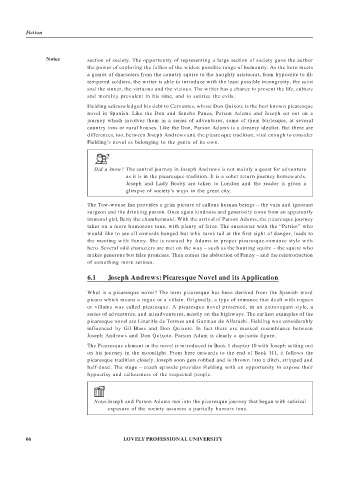Page 72 - DENG404_FICTION
P. 72
Fiction
Notes section of society. The opportunity of representing a large section of society gave the author
the power of exploring the follies of the widest possible range of humanity. As the hero meets
a gamut of characters from the country squire to the haughty aristocrat, from hypocrite to ill-
tempered soldiers, the writer is able to introduce with the least possible incongruity, the saint
and the sinner, the virtuous and the vicious. The writer has a chance to present the life, culture
and morality prevalent in his time, and to satirize the evils.
Fielding acknowledged his debt to Cervantes, whose Don Quixote is the best known picaresque
novel in Spanish. Like the Don and Sancho Panza, Parson Adams and Joseph set out on a
journey which involves them in a series of adventures, some of them burlesque, at several
country inns or rural houses. Like the Don, Parson Adams is a dreamy idealist. But there are
differences, too, between Joseph Andrews and the picaresque tradition, vital enough to consider
Fielding’s novel as belonging to the genre of its own.
Did u know? The central journey in Joseph Andrews is not mainly a quest for adventure
as it is in the picaresque tradition. It is a sober return journey homewards.
Joseph and Lady Booby are taken to London and the reader is given a
glimpse of society’s ways in the great city.
The Tow-wouse Inn provides a grim picture of callous human beings – the vain and ignorant
surgeon and the drinking parson. Once again kindness and generosity come from an apparently
immoral girl, Betty the chambermaid. With the arrival of Parson Adams, the picaresque journey
takes on a more humorous tone, with plenty of farce. The encounter with the “Patriot” who
would like to see all cowards banged but who turns tail at the first sight of danger, leads to
the meeting with Fanny. She is rescued by Adams in proper picaresque-romance style with
hero. Several odd characters are met on the way – such as the hunting squire – the squire who
makes generous but false promises. Then comes the abduction of Fanny – and the reintroduction
of something more serious.
6.1 Joseph Andrews: Picaresque Novel and its Application
What is a picaresque novel? The term picaresque has been derived from the Spanish word
picaro which means a rogue or a villain. Originally, a type of romance that dealt with rogues
or villains was called picaresque. A picaresque novel presented, in an extravagant style, a
series of adventures, and misadventures, mostly on the highways. The earliest examples of the
picaresque novel are Lizaritle de Tormes and Guzman de Alfarachi. Fielding was considerably
influenced by Gil Blass and Don Quixote. In fact there are marked resemblance between
Joseph Andrews and Don Quixote. Parson Adam is clearly a quixotic figure.
The Picaresque element in the novel is introduced in Book 1 chapter 10 with Joseph setting out
on his journey in the moonlight. From here onwards to the end of Book 111, it follows the
picaresque tradition closely. Joseph soon gets robbed and is thrown into a ditch, stripped and
half dead. The stage – coach episode provides Fielding with an opportunity to expose their
hypocrisy and callousness of the respected people.
Notes Joseph and Parson Adams run into the picaresque journey that began with satirical
exposure of the society assumes a partially humors tone.
66 LOVELY PROFESSIONAL UNIVERSITY

